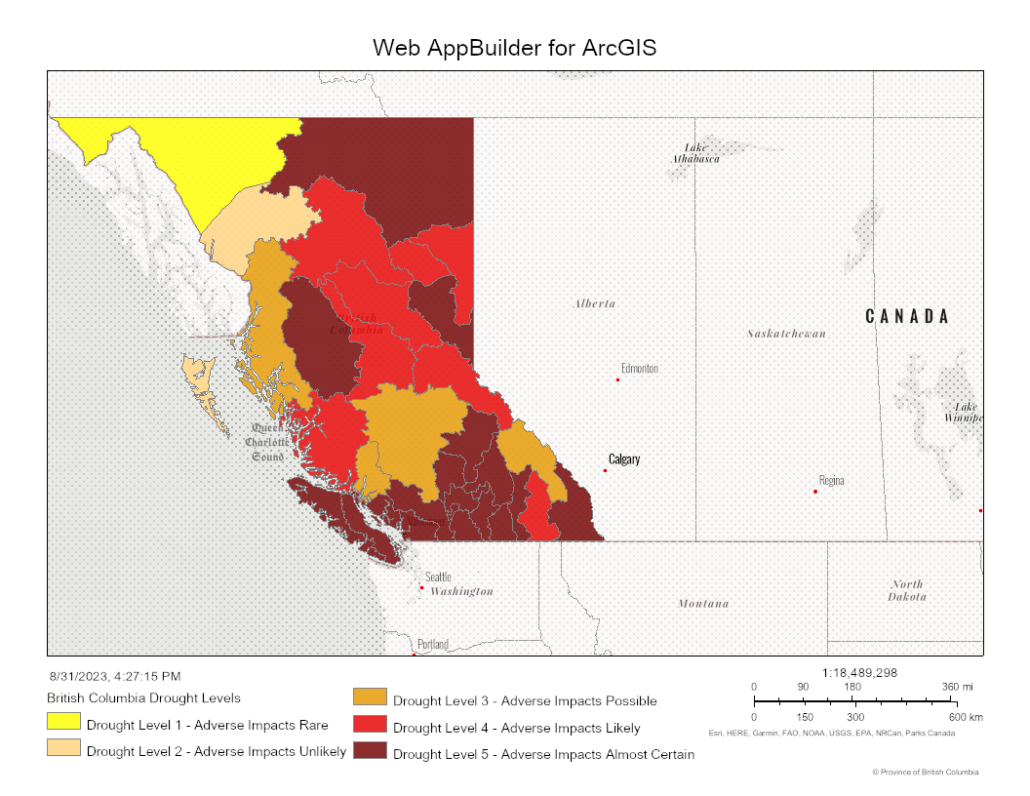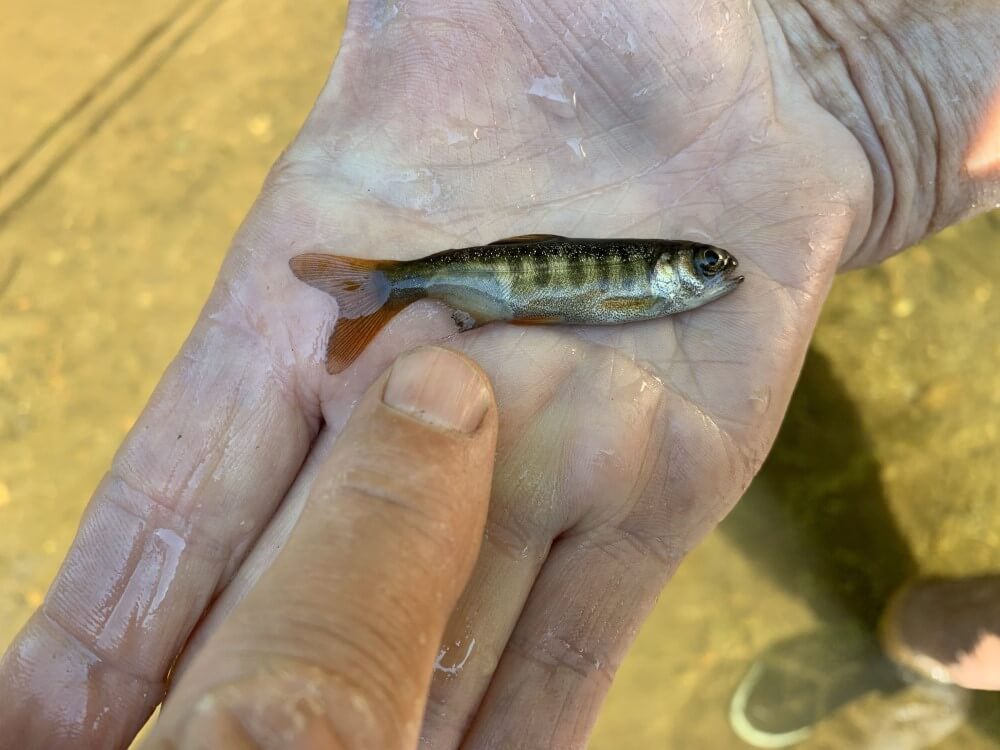Drought Strikes B.C. Again.
Sep 20, 2023|inBlog, Climate Adaptation Series, Salmon Steward
This story originally appeared in the Fall 2023 edition of Salmon Steward, the Pacific Salmon Foundation’s quarterly print magazine. The text in the digital article has been updated since the magazine was printed.
In 2021, 2022, and now 2023, B.C. has faced extreme drought conditions. However, so far in 2023, the province has experienced some of the most severe drought conditions on record.
By August, more than three-quarters of B.C.’s water basins were designated as Level Four or Level Five drought, the most severe drought classifications where adverse ecological and socio-economic impacts are likely or certain.
The Fraser River, renowned for its salmon run, had record low flows and experienced water temperatures up to five degrees above normal – conditions that spell trouble for salmon.
“Past droughts in B.C. were isolated to specific areas and watersheds. But this year, drought is an everywhere problem. Even the wettest areas in B.C. are seeing dry and hot conditions,” says Jason Hwang, PSF’s VP of Salmon.
“We are seeing significant impacts on salmon-bearing rivers and streams. Salmon returning to their freshwater habitats are facing these extreme drought stressors. It’s the equivalent of trying to run a marathon in a sauna.”
Drought increases overall stress for salmon. Warm water temperatures and low flows – typical drought characteristics – can be devastating for juvenile and adult salmon.

B.C.’s drought levels as of Aug. 31, 2023. (British Columbia Drought Information Portal
Climate change is expected to increase the intensity and frequency of extreme climate-related events – including floods, heatwaves, and droughts.
“Climate change is shifting what ’normal’ looks like in B.C. ecosystems,” says Jane Pendray, the manager of PSF’s Climate Adaptation Program. “The scale of climate issues is ramping up. Extreme events like drought are getting bigger than we’re used to, creating new challenges for salmon.”
When the Province of B.C. forecasted a high risk of province-wide drought in June, PSF saw an opportunity to act fast. Anticipating likely effects on salmon, PSF convened a rapid response working group with DFO, the Province, and technical experts to start planning for in-season solutions.
Warm waters, low flows, and low oxygen levels induced by drought can:
• Reduce water levels and therefore habitat availability
• Strand salmon in disconnected pools
• Cause on-route mortalities for adult salmon swimming to their spawning grounds
• Delay the timing of the salmon reproductive cycle and desynchronize their overlap with seasonal foods
Together, PSF and partners mobilized efforts and funding, thanks to the Province of B.C., to coordinate new monitoring initiatives and activate emergency response projects to help salmon survive challenging conditions.
“We piloted brand-new strategies that have never been done before because we need to do everything we can to help salmon adapt to climate change,” says Pendray. “Drought is more intense, longer lasting, and more extensive across B.C. than it has been in the past, so we can no longer rely on plans and actions that used to be effective. We need to think outside the box”
PSF has provided more than $300,000 for projects approved by the rapid response working group, enabling local entities to activate drought emergency projects on the ground to support salmon. Looking beyond projects on fish salvage and focusing on improving habitat, examples of projects include:
The mouth of the Tranquille River, approximately 15 kilometres west of Kamloops, went dry by early August. An early and intense spring freshet deposited excess sediment at the river mouth, which was then followed by Level Five drought conditions in the summer, creating a barrier for fish passage that would limit salmon spawning to the lower sections of the river.
As pink and coho salmon spawners were set to return in September, DFO developed a plan to repair the habitat by using an excavator to re-establish water flow between the upper and lower sections of the river and enable salmon to migrate to their spawning grounds upstream.
With funding from the rapid response working group, the emergency repair took place in early September just in time for local salmon returns. Additionally, water licence holders, with assistance from Secwepemc Fisheries Commission and provincial staff, enacted plans to release extra water from upper watershed storage to support returning salmon during their critical migration.
In July, the Tsolum River on eastern Vancouver Island near Courtenay reached Level Five drought. The Tsolum is also one of four streams in the province where temporary protection orders limiting water use to protect flows for fish were introduced in August. The Tsolum River Restoration Society (TRSS) noted dangerously low flows and high water temperatures that threatened juvenile salmon survival and the spawning success of returning pink salmon.
Low dissolved oxygen induced by drought conditions was a major challenge for survival in the refuge pools in the river. TRSS proposed an innovative solution: installing solar- and generator-powered aeration units in the pools to improve salmon survival during the drought.
TRSS requested funding in August from the rapid response working group to initiate the project with support from K’omok’s First Nation and DFO. The rapid response group approved the application within days, allowing the partners to get started immediately.
In addition to aerating the refuge pools, TRSS and local collaborators improved connectivity between side channels caused by low flows, installed overhead shading where riparian cover was low, and placed natural materials such as logs near refugia to provide shade and cover.

A juvenile coho in the lower Tsolum River in July 2022 with a bacterial infection likely caused by increased pollutants due to low flows from drought conditions. (Allan Chamberlain)
PSF also launched an online tool for the public to report local drought conditions that are impacting salmon survival or migration. Since the tool was launched in August, issues across B.C. have been identified by concerned citizens for salmon and shared with DFO and the Province, who connect with staff on the ground, local First Nations, and streamkeepers to assess problems, monitor conditions, and intervene when necessary.
After the drought season, PSF’s data specialists will compile the submissions into a public-access map or summary report to serve as a reference resource when planning for future drought years.
Thanks to the Province of B.C., PSF was able to fund time-sensitive projects to help salmon survive drought conditions. With your help, we can grow our Climate Adaptation Fund – enabling timely, nimble responses to climate events impacting salmon and their habitats.
Donate today!

 Artificial intelligence to monitor wild salmon
Artificial intelligence to monitor wild salmon